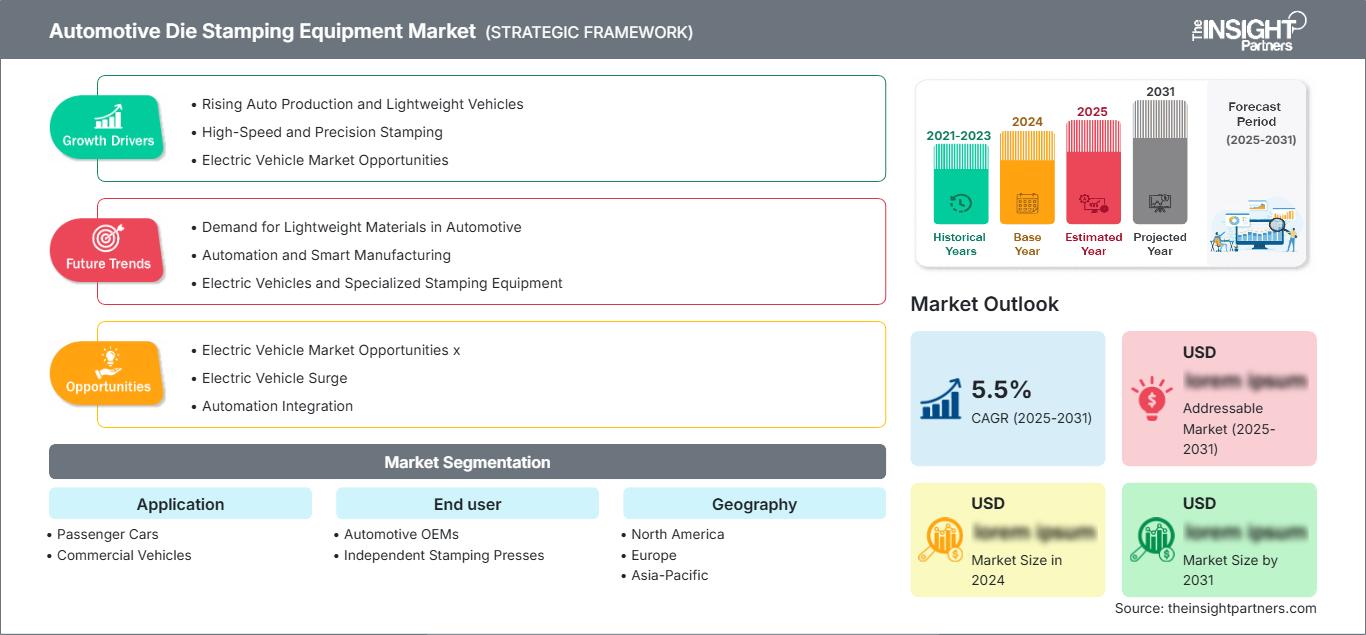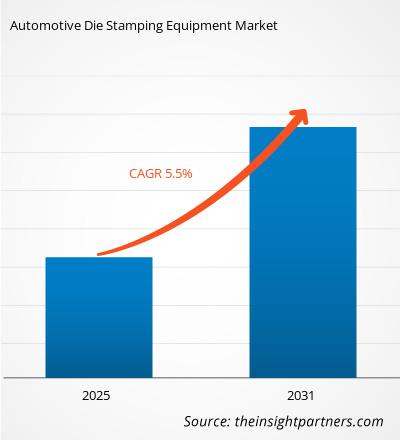Der Markt für Stanzmaschinen für die Automobilindustrie wird voraussichtlich zwischen 2025 und 2031 eine durchschnittliche jährliche Wachstumsrate (CAGR) von 5,5 % verzeichnen, wobei die Marktgröße von XX Millionen US-Dollar im Jahr 2024 auf XX Millionen US-Dollar im Jahr 2031 anwachsen wird.
Der Markt ist nach Anwendung und Endbenutzer segmentiert. Das Anwendungssegment ist in Pkw und Nutzfahrzeuge unterteilt. Basierend auf dem Endbenutzer ist der globale Markt für Stanzmaschinen für die Automobilindustrie in Automobilhersteller und unabhängige Stanzpressen segmentiert.
Zweck des Berichts
Der Bericht „Markt für Stanzmaschinen für die Automobilindustrie“ von The Insight Partners zielt darauf ab, die aktuelle Situation und das zukünftige Wachstum sowie die wichtigsten treibenden Faktoren, Herausforderungen und Chancen zu beschreiben. Dies bietet verschiedenen Geschäftspartnern Einblicke, wie beispielsweise:
- Technologieanbieter/-hersteller: Um die sich entwickelnde Marktdynamik zu verstehen und die potenziellen Wachstumschancen zu kennen, damit sie fundierte strategische Entscheidungen treffen können.
- Investoren: Um eine umfassende Trendanalyse hinsichtlich der Marktwachstumsrate, der finanziellen Marktprognosen und der Chancen entlang der Wertschöpfungskette durchzuführen.
- Regulierungsbehörden: Um Richtlinien und Überwachungsaktivitäten auf dem Markt zu regulieren, mit dem Ziel, Missbrauch zu minimieren, das Vertrauen der Investoren zu wahren und die Integrität und Stabilität des Marktes aufrechtzuerhalten.
Anwendung der Marktsegmentierung für Stanzgeräte für Kraftfahrzeuge
- Pkw
- Nutzfahrzeuge
Endverbraucher
- Automobilhersteller
- Unabhängige Stanzpressen
Sie erhalten kostenlos Anpassungen an jedem Bericht, einschließlich Teilen dieses Berichts oder einer Analyse auf Länderebene, eines Excel-Datenpakets sowie tolle Angebote und Rabatte für Start-ups und Universitäten.
Markt für Stanzgeräte für die Automobilindustrie: Strategische Einblicke

- Holen Sie sich die wichtigsten Markttrends aus diesem Bericht.Dieses KOSTENLOSE Beispiel umfasst Datenanalysen, die von Markttrends bis hin zu Schätzungen und Prognosen reichen.
Wachstumstreiber für den Markt für Stanzmaschinen für die Automobilindustrie
- Steigende Produktion von Elektrofahrzeugen: Der Übergang der Automobilindustrie zu Elektrofahrzeugen treibt die Nachfrage nach besseren Stanzmaschinen weiter an. Elektrofahrzeuge erfordern oft spezielle Komponenten und leichte Materialien, die mithilfe fortschrittlicher Stanztechnologien leicht hergestellt werden können. Die größere und steigende Anzahl von Elektrofahrzeugen im Bestand erhöht die Nachfrage nach innovativen Stanzlösungen entscheidend.
- Steigende Nachfrage nach Leichtbaumaterialien: Im Automobilsektor geht der Trend zur Verwendung von Leichtbaumaterialien wie Aluminium und hochfestem Stahl im Hinblick auf Kraftstoffeffizienz und Emissionen. Stanzmaschinen werden für komplexe Automobilteile benötigt. Diese steigende Nachfrage nach Leichtbauteilen treibt die Nachfrage auf dem Markt für Stanzmaschinen an.
Zukünftige Trends auf dem Markt für Stanzmaschinen für die Automobilindustrie
- Fokus auf Nachhaltigkeit: Die zunehmende Bedeutung der Nachhaltigkeit im Automobilsektor unterstreicht allmählich die Bedeutung dieser Konzepte auf dem Markt für Stanzmaschinen. Unternehmen verstärken ihre Bemühungen um umweltfreundliche Praktiken, darunter Abfallreduzierung und geringerer Energieverbrauch bei Stanzprozessen. Dies ist Teil des übergeordneten Ziels, die Umweltbelastung zu verringern und Innovationen in der Stanztechnologie zu fördern.
- Individualisierung und Vielseitigkeit: Mit dem Trend zur zunehmenden Individualisierung im Automobilbau steigt der Bedarf an flexibleren Stanzanlagen. Da die Kunden immer mehr personalisierte Autos bevorzugen, ermöglichen Stanzlösungen eine schnelle Anpassung an verschiedene Designs und Kundenspezifikationen. Der Trend zur Differenzierung führt zu einem Bedarf an flexiblen, modularen Stanzsystemen, die sich an die Produktionsanforderungen anpassen lassen.
Marktchancen für Stanzanlagen für die Automobilindustrie
- Technologischer Fortschritt: Intelligente Fertigungstechnologien, darunter Automatisierung und Robotik, erweitern die Chancen für den Markt für Stanzanlagen. Durch die Nutzung dieser technologischen Fortschritte können Hersteller die Produktion effizienter gestalten und gleichzeitig Arbeitskosten einsparen und arbeitsbedingte Abweichungen im Stanzprozess minimieren. Unternehmen, die sich durch den Einsatz modernster Technologie Vorteile verschaffen, können auf dem Markt wettbewerbsfähig bleiben.
- Industrieerweiterung: Die Automobilbranche in Entwicklungsländern verzeichnet ein enormes Wachstum. Infolgedessen steigen dort die Investitionen in Fertigungskapazitäten. Mit der Expansion der Schwellenländer können Hersteller von Stanzanlagen in diese Regionen expandieren und Partnerschaften mit lokalen Automobilherstellern eingehen. Mit der Entwicklung der Automobilindustrie in diesen Regionen wird der Markt für effektive Stanzlösungen wachsen.
Markt für Stanzgeräte für die Automobilindustrie
Die Analysten von The Insight Partners haben die regionalen Trends und Faktoren, die den Markt für Automobil-Stanzmaschinen im Prognosezeitraum beeinflussen, ausführlich erläutert. In diesem Abschnitt werden auch die Marktsegmente und die geografische Lage in Nordamerika, Europa, dem asiatisch-pazifischen Raum, dem Nahen Osten und Afrika sowie Süd- und Mittelamerika erörtert.Umfang des Marktberichts über Stanzgeräte für die Automobilindustrie
| Berichtsattribut | Einzelheiten |
|---|---|
| Marktgröße in 2024 | US$ XX million |
| Marktgröße nach 2031 | US$ XX Million |
| Globale CAGR (2025 - 2031) | 5.5% |
| Historische Daten | 2021-2023 |
| Prognosezeitraum | 2025-2031 |
| Abgedeckte Segmente |
By Anwendung
|
| Abgedeckte Regionen und Länder | Nordamerika
|
| Marktführer und wichtige Unternehmensprofile |
|
Dichte der Marktteilnehmer für Stanzgeräte für die Automobilindustrie: Verständnis ihrer Auswirkungen auf die Geschäftsdynamik
Der Markt für Stanzmaschinen für die Automobilindustrie wächst rasant. Die steigende Nachfrage der Endverbraucher ist auf Faktoren wie veränderte Verbraucherpräferenzen, technologische Fortschritte und ein stärkeres Bewusstsein für die Produktvorteile zurückzuführen. Mit der steigenden Nachfrage erweitern Unternehmen ihr Angebot, entwickeln Innovationen, um den Bedürfnissen der Verbraucher gerecht zu werden, und nutzen neue Trends, was das Marktwachstum weiter ankurbelt.
- Holen Sie sich die Markt für Stanzgeräte für die Automobilindustrie Übersicht der wichtigsten Akteure
Wichtige Verkaufsargumente
- Umfassende Abdeckung: Der Bericht analysiert umfassend Produkte, Dienstleistungen, Typen und Endnutzer des Marktes für Stanzmaschinen für die Automobilindustrie und bietet einen ganzheitlichen Überblick.
- Expertenanalyse: Der Bericht basiert auf dem umfassenden Verständnis von Branchenexperten und Analysten.
- Aktuelle Informationen: Der Bericht gewährleistet Geschäftsrelevanz durch die Berichterstattung über aktuelle Informationen und Datentrends.
- Anpassungsoptionen: Dieser Bericht kann an spezifische Kundenanforderungen angepasst werden und passt sich optimal an die Geschäftsstrategien an.
Der Forschungsbericht zum Markt für Stanzmaschinen für die Automobilindustrie kann daher dazu beitragen, die Branchensituation und die Wachstumsaussichten zu entschlüsseln und zu verstehen. Obwohl es einige berechtigte Bedenken geben mag, überwiegen die Vorteile dieses Berichts tendenziell die Nachteile.
- Historische Analyse (2 Jahre), Basisjahr, Prognose (7 Jahre) mit CAGR
- PEST- und SWOT-Analyse
- Marktgröße Wert/Volumen – Global, Regional, Land
- Branchen- und Wettbewerbslandschaft
- Excel-Datensatz
Aktuelle Berichte
Erfahrungsberichte
Grund zum Kauf
- Fundierte Entscheidungsfindung
- Marktdynamik verstehen
- Wettbewerbsanalyse
- Kundeneinblicke
- Marktprognosen
- Risikominimierung
- Strategische Planung
- Investitionsbegründung
- Identifizierung neuer Märkte
- Verbesserung von Marketingstrategien
- Steigerung der Betriebseffizienz
- Anpassung an regulatorische Trends




















 Kostenlose Probe anfordern für - Markt für Stanzgeräte für die Automobilindustrie
Kostenlose Probe anfordern für - Markt für Stanzgeräte für die Automobilindustrie